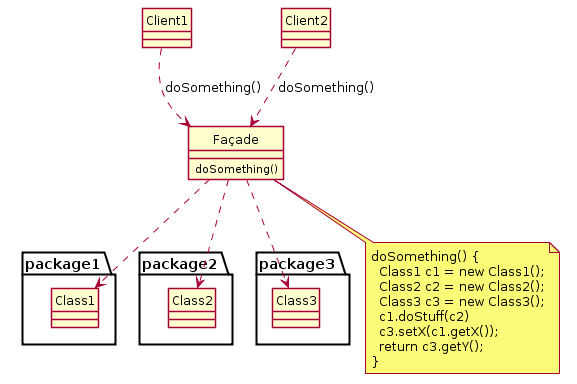Facade pattern
The facade pattern (or façade pattern) is a software design pattern commonly used with object-oriented programming. The name is by analogy to an architectural facade.
A facade is an object that provides a simplified interface to a larger body of code, such as a class library. A facade can:
- make a software library easier to use, understand and test, since the facade has convenient methods for common tasks;
- make the library more readable, for the same reason;
- reduce dependencies of outside code on the inner workings of a library, since most code uses the facade, thus allowing more flexibility in developing the system;
- wrap a poorly designed collection of APIs with a single well-designed API.
The Facade design pattern is often used when a system is very complex or difficult to understand because the system has a large number of interdependent classes or its source code is unavailable. This pattern hides the complexities of the larger system and provides a simpler interface to the client. It typically involves a single wrapper class which contains a set of members required by client. These members access the system on behalf of the facade client and hide the implementation details.
Usage
A Facade is used when an easier or simpler interface to an underlying object is desired.[1] Alternatively, an adapter can be used when the wrapper must respect a particular interface and must support polymorphic behavior. A decorator makes it possible to add or alter behavior of an interface at run-time.
| Pattern | Intent |
|---|---|
| Adapter | Converts one interface to another so that it matches what the client is expecting |
| Decorator | Dynamically adds responsibility to the interface by wrapping the original code |
| Facade | Provides a simplified interface |
The facade pattern is typically used when:
- a simple interface is required to access a complex system;
- the abstractions and implementations of a subsystem are tightly coupled;
- need an entry point to each level of layered software; or
- a system is very complex or difficult to understand.
Structure

- Facade
- The facade class abstracts Packages 1, 2, and 3 from the rest of the application.
- Clients
- The objects are using the Facade Pattern to access resources from the Packages.
Example
This is an abstract example of how a client ("you") interacts with a facade (the "computer") to a complex system (internal computer parts, like CPU and HardDrive).
C#
Implementation
namespace Designpattern.Facade
{
class SubsystemA
{
public string OperationA1()
{
return "Subsystem A, Method A1\n";
}
public string OperationA2()
{
return "Subsystem A, Method A2\n";
}
}
class SubsystemB
{
public string OperationB1()
{
return "Subsystem B, Method B1\n";
}
public string OperationB2()
{
return "Subsystem B, Method B2\n";
}
}
class SubsystemC
{
public string OperationC1()
{
return "Subsystem C, Method C1\n";
}
public string OperationC2()
{
return "Subsystem C, Method C2\n";
}
}
public class Facade
{
private readonly SubsystemA a = new SubsystemA();
private readonly SubsystemB b = new SubsystemB();
private readonly SubsystemC c = new SubsystemC();
public void Operation1()
{
Console.WriteLine("Operation 1\n" +
a.OperationA1() +
b.OperationB1() +
c.OperationC1());
}
public void Operation2()
{
Console.WriteLine("Operation 2\n" +
a.OperationA2() +
b.OperationB2() +
c.OperationC2());
}
}
}
Sample code
namespace DesignPattern.Facade.Sample
{
// The 'Subsystem ClassA' class
class CarModel
{
public void SetModel()
{
Console.WriteLine(" CarModel - SetModel");
}
}
/// <summary>
/// The 'Subsystem ClassB' class
/// </summary>
class CarEngine
{
public void SetEngine()
{
Console.WriteLine(" CarEngine - SetEngine");
}
}
// The 'Subsystem ClassC' class
class CarBody
{
public void SetBody()
{
Console.WriteLine(" CarBody - SetBody");
}
}
// The 'Subsystem ClassD' class
class CarAccessories
{
public void SetAccessories()
{
Console.WriteLine(" CarAccessories - SetAccessories");
}
}
// The 'Facade' class
public class CarFacade
{
private readonly CarModel model;
private readonly CarEngine engine;
private readonly CarBody body;
private readonly CarAccessories accessories;
public CarFacade()
{
model = new CarModel();
engine = new CarEngine();
body = new CarBody();
accessories = new CarAccessories();
}
public void CreateCompleteCar()
{
Console.WriteLine("******** Creating a Car **********");
model.SetModel();
engine.SetEngine();
body.SetBody();
accessories.SetAccessories();
Console.WriteLine("******** Car creation is completed. **********");
}
}
// Facade pattern demo
class Program
{
static void Main(string[] args)
{
var facade = new CarFacade();
facade.CreateCompleteCar();
Console.ReadKey();
}
}
}
Java
/* Complex parts */
class CPU {
public void freeze() { ... }
public void jump(long position) { ... }
public void execute() { ... }
}
class Memory {
public void load(long position, byte[] data) { ... }
}
class HardDrive {
public byte[] read(long lba, int size) { ... }
}
/* Facade */
class ComputerFacade {
private CPU processor;
private Memory ram;
private HardDrive hd;
public ComputerFacade() {
this.processor = new CPU();
this.ram = new Memory();
this.hd = new HardDrive();
}
public void start() {
processor.freeze();
ram.load(BOOT_ADDRESS, hd.read(BOOT_SECTOR, SECTOR_SIZE));
processor.jump(BOOT_ADDRESS);
processor.execute();
}
}
/* Client */
class You {
public static void main(String[] args) {
ComputerFacade computer = new ComputerFacade();
computer.start();
}
}
Ruby
# Complex Parts
class CPU
def freeze; end
def jump(position); end
def execute; end
end
class Memory
def load(position, data); end
end
class HardDrive
def read(lba, size); end
end
# Facade
class ComputerFacade
def initialize
@processor = CPU.new
@ram = Memory.new
@hd = HardDrive.new
end
def start
@processor.freeze
@ram.load(BOOT_ADDRESS, @hd.read(BOOT_SECTOR, SECTOR_SIZE))
@processor.jump(BOOT_ADDRESS)
@processor.execute
end
end
# Client
computer_facade = ComputerFacade.new
computer_facade.start
References
- ↑ Freeman, Eric; Freeman, Elisabeth; Sierra, Kathy; Bates, Bert (2004). Hendrickson, Mike; Loukides, Mike, eds. "Head First Design Patterns" (paperback). 1. O'Reilly: 243, 252, 258, 260. ISBN 978-0-596-00712-6. Retrieved 2012-07-02.
External links
| The Wikibook Computer Science Design Patterns has a page on the topic of: Facade implementations in various languages |
| Wikimedia Commons has media related to Facade pattern. |